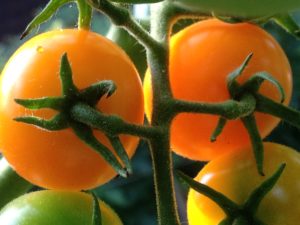
NOT infected Sungold tomatoes
This summer has not been great for growing tomatoes. It was cold, then it was cold, and after it got hot, it then got cold again. Finally, as the weather seems to be warm long enough to keep the tomatoes happy, Late Blight is approaching.
Time to spray.
Late Blight, as most of you probably know, is the disease that wiped out Ireland’s potato crop and led to the “Great Famine.” You may also know that since potatoes and tomatoes are in the same family, the disease can destroy both crops with lightning speed.
Late Blight has been found in western/central MA already (Franklin and Hampshire counties). The spores of the disease are carried by wind and can travel great distances rapidly. A great way to keep tabs on the spread is by signing up for emails through USAblight. You set the parameters (eg, only notify me if there’s an infection within 200 miles of me) and you’ll get an email if and when an infection is confirmed.
That means you need to spray NOW if you want to prevent disease. Spraying once your tomato or potato plants are infected is futile. To the poo-poo’ers: No, local infection does not mean your crops will get infected. If you want to risk infection with your plants, I’ve got no issue with that. However, if your plants do get infected, do us all a favor by pulling, bagging and throwing away (NOT composting, unless you know what you’re doing) those infected plants, especially infected potatoes, ASAP, okay? Thanks.
What to spray:
There are a number of fungicides that will protect crops from Late Blight, though all require the user to spray them appropriately and according to the label. Importantly, you need to spray the whole plant. In some cases (such as copper sprays) this means you should not eat any fruit for some period of time (sometimes hours, sometimes days). READ THE LABEL!
Organic farmers often use copper. I know several people who swear by Actinovate, a soil-borne bacteria. (Take heed of the “use by” date on Actinovate, and note that it is expensive.)
I am a big fan of Serenade.
Serenade can be purchased in spray bottles or in concentrate. I mix some up in my favorite one gallon sprayer and go to town on tomato plants and I’ve had great success this way.
Here’s where I feel Serenade is a better option (for me) than the others: After I spray the tomatoes, I can spray the melons because Serenade kills off/prevents Powdery Mildew. I then spray the beans to control Bean Rust. It works on several other diseases (including common diseases of tomatoes). I can use that one mix on a number of plants to control a wide variety of diseases, and eat the produce the same day it is sprayed.
At this point I want to make clear once again that I did NOT get paid or receive any gifts for saying any of this, the same way I never get paid. If that ever changes, I’ll let you know.
